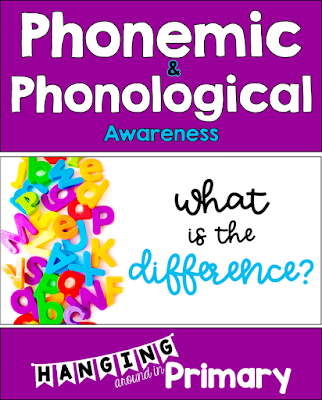If you’ve ever caught yourself using phonemic awareness and phonological awareness interchangeably, you’re not alone. These two foundational literacy skills are closely connected—but not quite the same. Knowing the difference can make a big impact on how you support early readers. In this post, we’ll unpack the key differences between phonological and phonemic awareness, when to teach each one, and how to assess your students.
Many teachers—even seasoned ones—get tripped up by the terms. And no wonder! The skills often overlap, and educational resources don’t always use the terms consistently. But without a clear understanding of what these terms actually mean, it’s hard to identify gaps in students’ foundational reading skills—or know how to fill them.
What is Phonological Awareness?
Phonological awareness is the umbrella term that covers a wide range of sound-related skills, including:
- Recognizing rhymes (e.g., sing, wing, ding)
- Counting syllables in words (e.g., cup-cake has two)
- Identifying onset and rime (e.g., c in cat, -ake in cake)
It encompasses the many ways sounds/phonemes function in words. It goes beyond just the phoneme level and delves into syllable, rhyme, and onset/rime.
What is Phonemic Awareness?
A simple phonemic awareness definition is that it falls under the broader umbrella of phonological awareness and focuses specifically on the smallest units of sound: phonemes. It's:
- An auditory skill (not connected to print)
- About hearing and manipulating sounds in words
- Essential for blending and segmenting sounds
For example, a student with strong phonemic awareness can hear that man is made of the sounds /m/ /a/ /n/ and can switch the /m/ to /p/ and make pan.
I like to have a quick reference sheet handy to keep all the skills straight. You can download it for free by clicking on the image.
Phonological And Phonemic Awareness: What's the Real Difference?
| Feature | Phonological Awareness | Phonemic Awareness |
|---|---|---|
| Scope | Broad — includes rhyme, syllables and onset/rime | Narrow — focused specifically on individual phonemes |
| Focus | General sound structure and play in spoken language | Hearing and manipulating individual sounds in words |
| Skills | Rhyming, syllable counting, onset/rime recognition | Isolating, blending, segmenting, and substituting phonemes |
| Example Activity | Clap syllables in "cupcake" or find rhymes for "sing" | Blend /c/ /a/ /t/ to say "cat"; change /c/ to /b/ to make "bat" |
| Teaching Stage | Preschool to early elementary — foundational awareness | Pre-reading and early reading instruction — supports decoding |
When should you teach Phonemic Awareness?
Phonemic awareness is a critical precursor to reading.
Ideally, children coming from kindergarten will have had lots of phonemic awareness instruction and have solid phonemic awareness skills. However, we all know
skill development isn’t one-size-fits-all.
We all know that children progress at different rates in their learning. For this reason, as a first-grade teacher, you should be prepared to teach phonemic awareness right from the start of the school year.
Second- and third-grade teachers who have students struggling to read should also assess their students' phonemic awareness to identify any remaining gaps that may be holding them back.
- Kindergarten: Heavy focus on daily phonemic awareness activities
- First Grade: Reinforce, review, and assess for gaps
- Second/Third Grade: Use screeners if students are struggling to decode—missing phonemic awareness may be the root issue!
How do you know where to start?
Start with a screener to assess where your students are. Knowing which skills are missing helps you target instruction, whether in small groups or one-on-one.
Screening your students takes time, but it is well spent to inform your individualized and whole group instruction.
Ready to dive into phonemic awareness instruction with confidence?
Check out this set of over
235 phonemic awareness word lists
- explicitly designed to address all phonological and phonemic awareness skills.
These lists take the guesswork out of planning and make teaching oral skills easy, effective, and engaging.
Understanding the difference between phonological and phonemic awareness gives you the tools to catch reading struggles early and provide the proper support. With the right resources, you can build a strong foundation that helps students grow into confident readers.
If you’re ready for classroom-ready materials, explore the phonemic awareness products linked in this post—or grab the quick reference sheet to keep the skills clear at a glance. Every step you take now makes reading success easier for your students later.



















.png)









No comments